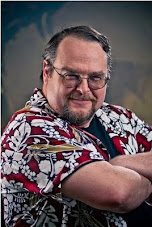The 39 Steps, Adapted by Patrick Barlow, Based on an Original Concept by Simon Corble & Nobby Dimon, Based on the book by John Buchan, (but based more on the Alfred Hitchcock-directed movie written by Charles Bennett (adaptation) and Ian Hay (dialogue)),Directed by Maria Aitken. Seattle Repertory Theatre, Through 24 October 2009.
The Seattle Rep slides into its new season with a comedy, not exactly lightweight but definitely buoyant, based on a movie based on a book.
As can be denoted from the annotated credits above, The 39 Steps has a storied heritage. Indeed, it seems like the Book of Matthew has fewer "begats". Originally a popular pre-WWI Spy novel by John Buchan, it was reinvented (keeping the name, tweaking the main character, adding female characters, changing the meaning of the title) by Alfred Hitchcock into the version that modern audiences know. The play, then, is deeply based on this Hitchcock version.
Here's the overview. Richard Hannay (Ted Deasy) is bored and goes to the theater, where he hooks up with a foreign-accented damsel in distress (Claire Brownell), who meets a horrible fate in his digs, for which he is blamed. To prove his innocence, Hannay flees to Scotland, where he confronts a larger plot and gets himself into more scrapes and escapes as he struggles to figure out the meaning of the Thirty-Nine Steps.
Turning a movie (with motion, chase scenes, vistas, and changing scenes) into a play (with constricted space and time limitations) is a challenge, and all the moreso since the team uses but four actors - Deasy as the stiff-upper lip Canadian Hannay, Brownell in all the female roles, and Eric Hissom and Scott Parkinson as everybody else. Yes, really, everybody else. Hissom channels an inner James Coco, while Scott Parkinson elastically and plastically morphs between characters with a frightening ease.
And unlike the film, it is played for fun. The characters are very much aware that they are in a play, from the running gag of continual wind blowing to uncooperative terrain for a flight across the moors. There are evocations of Python and rapid-fire 30s banter, and eye-rolling shout-outs to other Hitchcock films. Every accent is dialed up to 11 or 12. Despite that, the thriller aspect refuses to be subdued, and bubbles to the surface, capturing a chase across the top of a train and a singularly Hitchcockian moment when the hero is mistaken for a wrong man, but in this case mistaken for a man about to give a political speech (a basic fear played both lightly and with the growing suspense of being discovered).
And there's a bit more going on here, a little bit of depth about the Hannay's own personal journey. He's a Hitchcock hero - the wrong man in the wrong place, but over the course of his fight resolves his own internal problems that exist at the play's outset. So we have the recognized layer of the thriller, with a coating of comedy on top and an underlying bit of real character development beneath.
So we have a piece that has passed through the creative processes of a numerous talents to create a final process. It works, it is a light beginning to the season, and an excellent afternoon's play. You don't have to be a fan of Hitchcock (and the audience was younger than usually expected) to enjoy it.
More later,
My Newest Publication: DARK TOWER
-
*So, *
So, one of the things I saw at GaryCon that interested me greatly was the
new expanded edition of *DARK TOWER*, by the late great Jennnell Jaquay...
4 hours ago


